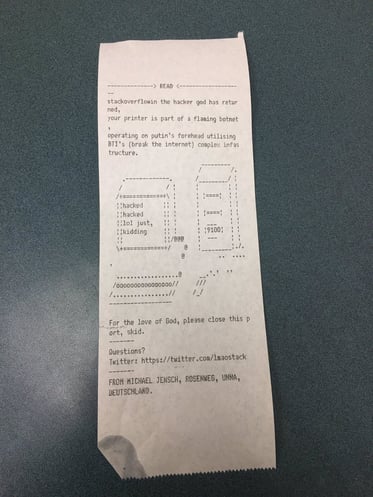A couple of weeks ago a high school student from the UK sent 150,000 printers around the world into a spin. After creating his own automated script, he detected insecure printers made by a wide range of companies (including HP, Brother, Epson and Canon) and instructed these printers to print a document informing victims that they had been hacked.
According to the teenager he only hacked the printers in an effort “to raise everyone’s awareness towards the dangers of leaving printers exposed online without a firewall or other security settings enabled.”
It appears from the reaction on social media that many of the printers affected by the hack are point of sale systems and office printers.
While sending pictures of robots to some random person’s printer can seem like a bit of fun, it actually highlights how vulnerable some of our devices can be, if a kid from the UK can write a script like that, imagine what a financially motivated professional hacker can achieve.
With more princely sums on offer, it’s no surprise that scammers and hackers are getting better and more sophisticated at what they do, in fact there has been a 39% increase in macro based malware (malware that hides in Word or Excel documents) in the last quarter.
A worrying report from the NSW Audit Office has revealed that some NSW Government Agencies have absolutely no strategy to deal with a sudden loss of infrastructure. These agencies are running 'financially significant' systems and if disaster hits and their servers are compromised, all the data will be lost.
A Disaster Recovery plan is much more than just having dusty backups of your data stacked up in the storeroom. It is a complete plan that outlines what the financial impact of a disaster will be on your business and provides a process to bring your systems back online in the most efficient way, having the least impact on your bottom line. Data recovery is sometimes confused with a Disaster Recovery Plan, but while data recovery may be able to save some files, they can’t put all your processes back in working order.






Let Us Know What You Thought about this Post.
Put your Comment Below.